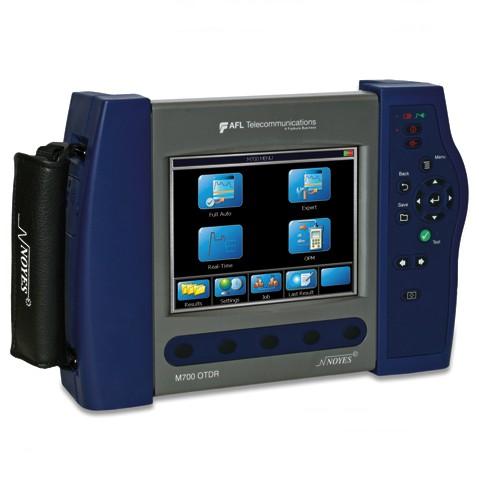
The M700 OTDR supports Real Time, Full-Auto, and Expert (manual) modes, precision event analysis, dual-wavelength testing, rich file naming, and intuitive job set-up functionality. In addition to OTDR event analysis, pass/fail acceptance values can be set to alert the test operator of failing or mar
Thousands of OTDR and OPM test results can be stored internally or on the supplied USB drive, and are transferable via a USB cable or USB drive to a computer for viewing, printing and analyzing with supplied Windows?compatible software. Saved OPM loss values for a cable in one or two directions can be displayed in a table on the M700 for evaluation and comparison.
With short dead zones, a dynamic range of 38 dB, and greater than 8-hour battery life during continuous testing, the M700 is perfect for testing optical fibers in service provider metro areas.
Features:
38/36 dB dynamic range @ 1310/1550 nm
Integrated Optical Power Meter (OPM) and Visual Fault Locator (VFL, 650 nm)
LSA Measurements and manual events in Expert mode
Pass/Fail Event and Link Thresholds settings
OTDR results saved as industry standard (GR-196) .SOR files
OPM stores results and displays up to three wavelengths simultaneously
Large, high bright, sunlight readable, transflective touchscreen
Tool-free, switchable adapters (SC/FC/LC)
Integrated fiber launch ring holder
2 USB host ports
USB drive and Windows?compatible software included

Touch Screen Icons and Descriptions: This is the recommended mode for users who are not familiar with OTDR operation. In the Full Auto mode, OTDR parameters such as Range, Pulse Width, and Averaging Time are set automatically. Tests are done at two wavelengths and always include an Event Table and Summary Page. Pass/Fail Thresholds are set to default with an option to be turned off. Expert OTDR mode is available for experienced users. It provides the most setup flexibility. Users can set Range, Pulse Width, and Averaging Time manually (Setup = Manual) or automatically (Setup = Auto Once or Setup = Auto). Users can either enable the event table (Events = Auto) or disable the event table (Events = Off).
OTDR
![]()
Note: in the Expert mode, the Events Menu contains Event Threshold and Pass/Fail Threshold Settings allowing the user to change these settings and turn them on or off.
OTDR
![]()
OTDR
![]()
Note: in the Expert mode, the Events Menu contains Event Threshold and Pass/Fail Threshold Settings allowing the user to change these settings and turn them on or off.
![]()
![]()
![]()
MORE SPECIFICATIONS WILL BE INFORMED BY SUNMA TEAM.